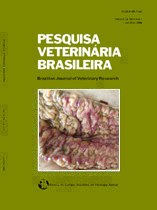 |
|
|
|
Year 2013 - Volume 33, Number 12
|

|
Detection of virulence-associated genes in Salmonella Enteritidis isolates from chicken in Southern Brazil, 33(12):1416-1422
|
ABSTRACT.- Borges K.A., Furian T.Q., Borsoi A., Moraes H.L.S., Salle C.T.P. & Nascimento V.P. 2013. Detection of virulence-associated genes in Salmonella Enteritidis isolates from chicken in Southern Brazil. Pesquisa Veterinária Brasileira 33(12):1416-1422. Centro de Diagnóstico e Pesquisa em Patologia Aviária, Faculdade de Veterinária, Universidade Federal do Rio Grande do Sul, Avenida Bento Gonçalves 8824, Porto Alegre, RS 91540-000, Brazil. E-mail: karen.borges@ufrgs.br
Salmonella spp. are considered the main agents of foodborne disease and Salmonella Enteritidis is one of the most frequently isolated serovars worldwide. The virulence of Salmonella spp. and their interaction with the host are complex processes involving virulence factors to overcome host defenses. The purpose of this study was to detect virulence genes in S. Enteritidis isolates from poultry in the South of Brazil. PCR-based assays were developed in order to detect nine genes (lpfA, agfA, sefA, invA, hilA, avrA, sopE, sivH and spvC) associated with the virulence in eighty-four isolates of S. Enteritidis isolated from poultry. The invA, hilA, sivH, sefA and avrA genes were present in 100% of the isolates; lpfA and sopE were present in 99%; agfA was present in 96%; and the spvC gene was present in 92%. It was possible to characterize the isolates with four different genetic profiles (P1, P2, P3 and P4), as it follows: P1, positive for all genes; P2, negative only for spvC; P3, negative for agfA; and P4, negative for lpfA, spvC and sopE. The most prevalent profile was P1, which was present in 88% of the isolates. Although all isolates belong to the same serovar, it was possible to observe variations in the presence of these virulence-associated genes between different isolates. The characterization of the mechanisms of virulence circulating in the population of Salmonella Enteritidis is important for a better understanding of its biology and pathogenicity. The frequency of these genes and the establishment of genetic profiles can be used to determine patterns of virulence. These patterns, associated with in vivo studies, may help develop tools to predict the ability of virulence of different strains. |
| |
|
|
| |
|
 |